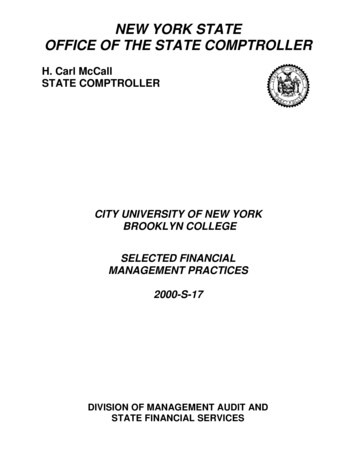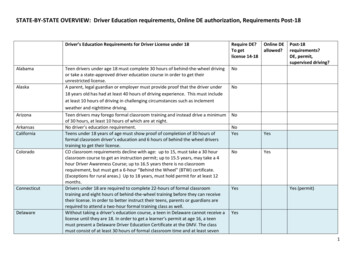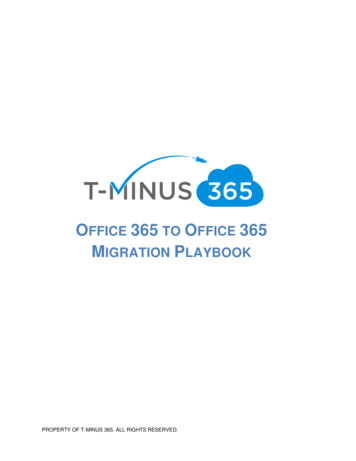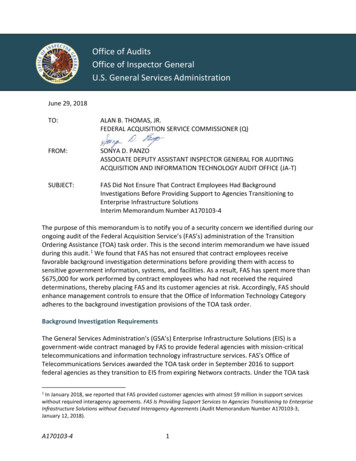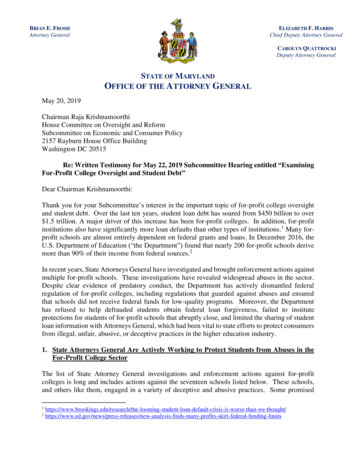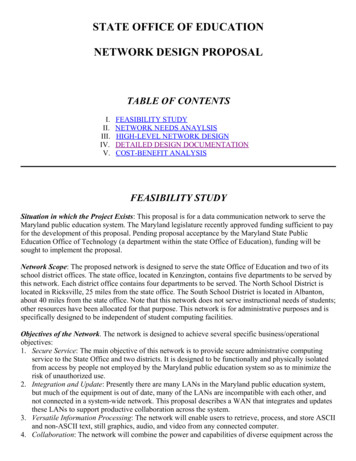
Transcription
STATE OFFICE OF EDUCATIONNETWORK DESIGN PROPOSALTABLE OF CONTENTSI.II.III.IV.V.FEASIBILITY STUDYNETWORK NEEDS ANAYLSISHIGH LEVEL NETWORK DESIGNDETAILED DESIGN DOCUMENTATIONCOST BENEFIT ANALYSISFEASIBILITY STUDYSituation in which the Project Exists: This proposal is for a data communication network to serve theMaryland public education system. The Maryland legislature recently approved funding sufficient to payfor the development of this proposal. Pending proposal acceptance by the Maryland State PublicEducation Office of Technology (a department within the state Office of Education), funding will besought to implement the proposal.Network Scope: The proposed network is designed to serve the state Office of Education and two of itsschool district offices. The state office, located in Kenzington, contains five departments to be served bythis network. Each district office contains four departments to be served. The North School District islocated in Ricksville, 25 miles from the state office. The South School District is located in Albanton,about 40 miles from the state office. Note that this network does not serve instructional needs of students;other resources have been allocated for that purpose. This network is for administrative purposes and isspecifically designed to be independent of student computing facilities.Objectives of the Network. The network is designed to achieve several specific business/operationalobjectives:1. Secure Service: The main objective of this network is to provide secure administrative computingservice to the State Office and two districts. It is designed to be functionally and physically isolatedfrom access by people not employed by the Maryland public education system so as to minimize therisk of unauthorized use.2. Integration and Update: Presently there are many LANs in the Maryland public education system,but much of the equipment is out of date, many of the LANs are incompatible with each other, andnot connected in a system wide network. This proposal describes a WAN that integrates and updatesthese LANs to support productive collaboration across the system.3. Versatile Information Processing: The network will enable users to retrieve, process, and store ASCIIand non ASCII text, still graphics, audio, and video from any connected computer.4. Collaboration: The network will combine the power and capabilities of diverse equipment across the
state to provide a collaborative medium that helps users combine their skills regardless of theirphysical location. A network for this educational community will enable people to share informationand ideas easily so they can work more efficiently and productively.5. Scalability: The design is scaleable so that more district offices can be added as funding becomesavailable without having to redo the installed network.Intended Users. The primary users of the network at the state level will be the three administrators, threesecretaries, ten members of the Curriculum Department, eight members of the Human ResourceDepartment, six members of the Finance/Accounting Department, and three members of the ComputerServices Department. At the district level the primary users will be four administrators, four secretaries,four members of the Computer Services Department, sixteen members of the Human ResourceDepartment, and two members of the Finance/Accounting Department. Parents, pre service teachers,teachers, and the public are secondary users of the network in that they will receive information producedon the network, but they will not directly use the network.Design Assumptions. This design assumes the following:1. The State Education Network has a firewall that protects all information coming and going from thenetwork.2. Internet service is provided by the State Education Network, which is subsidized by the stategovernment.NETWORK NEEDS ANALYSISData Types. The types of data served by the network will be reports, bulletins, accounting information,personnel profiles, and web pages. The majority of the data will be text (ASCII and non ASCII), butthere will be some still graphics and possibly a small amount of voice and video (primarily for PC basedteleconferencing).Data Sources. Data will be created and used at all end stations on the network. The data will be producedby software applications in Windows 2000, primarily Dream Weaver and Office 2000 Professional(Word, Excel, Access, PowerPoint, and Outlook). Other data sources to be supported on at least a limitedbasis will Windows 2000 Accessories (Paint, Notepad, etc.), NetMeeting, Media Player, and PhotoShop.Note that the network will be not be accessible from outside Numbers of Users and Priority Levels. At the state level, the users will be administrators, secretaries,and members of four departments. At the district levels, the users will be administrators, secretaries, andmembers of three departments. The maximum estimated number of users on the network at any giventime is 100: 33 regular users in the State Office, 30 regular users in the North District Office, 30 regularusers in the South District Office, and seven otherwise unanticipated users.Three priority levels will be supported: management (top priority), user (medium priority), andbackground (low priority). Note that these designations do not correspond to administrative levels in theMaryland public education system; rather, they are network service levels. Network managementprocesses will receive top priority service; most network processes will receive medium priority service;a few processes (e.g., e mail transfers, backup, etc.) will be given low priority service. It should be notedthat network management will usually consume a small amount of the available bandwidth; this meansthat management and user processes will usually enjoy identical support. Background processes will also
usually receive more than adequate service, but they will be delayed as needed to maintain support formanagement and user services.Transmission Speed Requirements. The network is to be transparent to the users. Thus, remotelyexecuted applications, file transfers, and so forth should ideally appear to operate as quickly as processesexecuted within an end station. Interviews with users to ascertain their needs and expectations indicatethat an average throughput of 20 mbps per user within each LAN and 10 mbps per user between LANswill more than support the needed performance in most cases (teleconferencing being the possibleexception).Load Variation Estimates. Interviews with users and observation of LAN use at the three locationsyielded data on hourly average and peak loads from January to March, 2001. The data are tabulated inthe appendix. The data indicate that the highest average traffic volume will occur from 8:00 a.m. to 6:00p.m., Monday through Friday. The peak network traffic volume is expected at two times during the day:8:00 a.m. to 12:00 noon and 3:00 p.m. to 5:00 p.m. At night and on weekends the network traffic isminimal except for the daily backups of the PCs to the LAN servers in the districts and several batch datatransfers anticipated from the districts to the State Office. The data indicate the following network designparameters: The average required throughput on any LAN during work hours (7:00 a.m. to 6:00 p.m.) will be onlyabout 0.2 mbps.The average required throughput on the WAN during work hours (7:00 a.m. to 6:00 p.m.) will beonly 0.04 mbps.The peak expected traffic load on any LAN will be about 10.4 mbps.The peak expected traffic load on the WAN will be about 6.4 mbps.Of course, to avoid user complaints, the network is designed for the peak traffic loads, not the averagethroughput.Storage Requirements. Storage requirements need to be large enough to store all student, teacher, andstate data (note: student data are data about students, not data generated by students). Interviews andobservations of users’ present and anticipated storage requirements indicate that each user will need anaverage of 100 MB of server space (in addition to secondary storage on local PCs); the maximumestimated server side storage requirement per user is about 1 GB. Additionally, the network operatingsystem will occupy about 500 MB on each LAN server. Taking price performance issues into account,each PC will have a minimum storage capacity of 10 GB, each LAN server will have a minimum storagecapacity of 20 GB. A main data server in the State Office will have a 36 GB capacity.Reliability Requirements. In keeping with user expectations and industry standards, both the LANs andthe WAN are expected to operate at 99.9% uptime and an undiscovered error rate of .001%.Security Requirements. A firewall will be used so unauthorized users will be restricted. Part of thesecurity will be Users accounts and passwords that will give limited access. There will be differentaccess capabilities for network managers and users.Existing Network. There is no existing network.
HIGH LEVEL NETWORK DESIGNTop Level Network DiagramState Office Network Diagram(LAN cabling is 100BaseT CAT5)
State Office Network Sub DiagramAdministration LANState Office Network Sub DiagramFinance/Accounting LAN
State Office Network Sub DiagramCurriculum LANState Office Network Sub DiagramHuman Resources LANState Office Network Sub DiagramComputer Services LAN
North District Network Diagram(LAN cabling is 100BaseT CAT5)North District Network Sub DiagramAdministration LAN
North District Network Sub DiagramFinance/Accounting & Computer Services LANNorth District Network Sub DiagramHuman Resources LAN
South District Network Diagram(LAN cabling is 100BaseT CAT5)South District Network Sub DiagramAdministration LANSouth District Network Sub DiagramFinance/Accounting & Computer Services LAN
South District Network Sub DiagramHuman Resources LANDETAILED DESIGN DOCUMENTATIONKey for Lists P File/Print Server LH 3000 4,089.00Available/In StockP3 866MHz, 128 MB/4GB RAM, 256KB L2, 32X CD3 Year Warranty and Maintained by Computer Services as neededHP NetServer Hard Drive 379.95Available/In Stock9.1 GB SCSI3 7200 RPM LVD, LC2000/LH3 Compatibility
Maintained by Computer Services as neededIntelliFax 4750 Commercial Laser Fax 499.95Available/In Stock250 sheet Universal Paper Cassette, 4 MB, Dual Access Memory (upgradeable to 12 MB or 20MB), Up to 50 page Auto Document Feeder, Stores up to 270 pages, 14.4 Kbps fax modemMaintained by Computer Services as neededHP Laser Jet 8150N Series 2,469.95Available/In Stock1200 dpi, 32 MB memory expandable to 192 MB, Network ready 10/100 Base TX, 2 open EIOSlots, 3/100 (Number of trays/capacity)Maintained by Computer Services as neededWindows 2000 Server 819.95Available/In Stock5 Licenses included, Full VersionMaintained by Computer Services as neededCompaq DeskPro EN P3/600 999.00Available/In Stock10 GB, 128 MB, 40X CD ROM, NIC DT Win 00; with Windows 2000 OS3 Year Parts and Labor Warranty and Maintained by Computer Services as neededCAT 5 Cable 145.99 Available/In Stock 4 pair solid PVC; 1000 feet Maintained by Computer Services as neededSmartPro 1400 454.99Available/In Stock6 outlets LANMaintained by Computer Services as neededEtherFast 8 Port 10/100 Desktop Hub 79.99Available/In StockTrue 10/100 auto sensing ports, Internal store and forward switching segment, built in datacollision and frame re timingManufacturer’s 5 year limited warranty and Maintained by Computer Services as neededEtherFast 12 Port 10/100 Desktop Hub 129.99Available/In Stock
True 10/100 auto sensing ports, Internal store and forward switching segment, built in datacollision and frame re timingManufacturer’s 5 year limited warranty and Maintained by Computer Services as neededEtherFast 20 Port 10/100 Desktop Hub 199.99Available/In StockTrue 10/100 auto sensing ports, Internal store and forward switching segment, built in datacollision and frame re timingManufacturer’s 5 year limited warranty and Maintained by Computer Services as neededEtherFast II 24 Port 10/100 Switch 449.99Available/In StockTrue 10/100 auto sensing ports, Internal store and forward intelligent switching segment, built indata collision and frame re timingManufacturer’s 5 year limited warranty and Maintained by Computer Services as neededCISCO 2621 Ethernet Router 2 10/100 2,319.00Available/In StockProvides remote access and WAN integrations, supports extranet VPN access and multiplemodules, two 10/100 RJ45 ports, two WAN slots, one network module slot, one AIM slotMaintained by Computer Services as neededFirewall I Internet Gateway V4.1 100 Nodes ONL 6,000.00Available/In StockFull VersionMaintained by Computer Services as neededDS 2 Connection 650.00Available1 month, exclusive rightsMaintained by Quest CommunicationsCOST BENEFIT ANALYSISCost AnalysisTangible CostsProductHP File/Print Server LH 3000HP NetServer Hard DriveIntelliFax 4750 Commercial Laser FaxHP Laser Jet 8150N SeriesWindows 2000 ServerPrice 4,089.00 379.95 499.95 2,469.95 819.95Quantity610346Total 24,534.003,799.501,499.859,879.804,919.70
Compaq DeskPro EN P3/600CAT 5 Cable (1,000 feet)SmartPro 1400EtherFast 8 Port 10/100 Desktop HubEtherFast 12 Port 10/100 Desktop HubEtherFast 20 Port 10/100 Desktop HubEtherFast II 24 Port 10/100 SwitchCISCO 2621 Ethernet Router 2 10/100Ports 2 SlotsRJ45 Plugs*Packs of 50Ultimate Tool KitFirewall I Internet Gateway V4.1 100Nodes ONLLabor (Maintaining the System) per hourDS 2 Connection (1 month, exclusiverights) 999.00 145.99 454.99 79.99 129.99 199.99 99.981,349.97 2,319.0036,957.00 49.998399.92 399.001399.00 6,000.0016,000.00 75.0030022,500.00 650.003623,400.00Subtotal of Tangible Costs 175,207.53Intangible CostsProductNetwork Down Time(Estimated at 9 hrs/yr)Price 8,000.00Subtotal of Intangible Costs1 8,000.00 8,000.00Total 3 year Cost AnalysisTotal Annualized Cost 183,207.53 61,069.18Benefit AnalysisProductIncrea
NETWORK DESIGN PROPOSAL . sought to implement the proposal. Network Scope: The proposed network is designed to serve the state Office of Education and two of its school district offices. The state office, located in Kenzington, contains five departments to be served by this network. Each district office contains four departments to be served. The North School District is located in .
